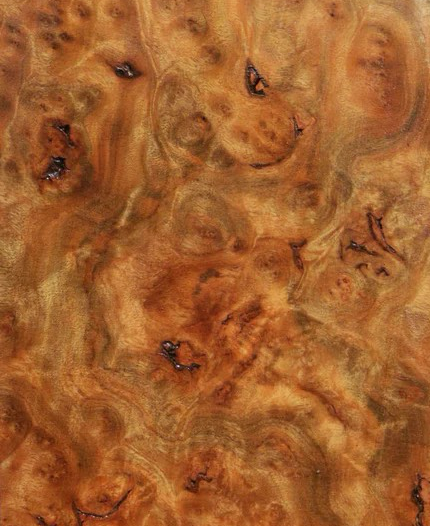
Camphor Burl
Camphor Burl, derived from the Cinnamomum camphora tree, is a rare and highly prized burl wood native to Southeast Asia, including regions like Japan, Taiwan, and Myanmar. It’s part of the laurel family, known for its evergreen trees that can grow 60–100 feet tall with trunk diameters of 2–4 feet. The burl itself forms as a large, irregular growth on the tree, sometimes as big as a Volkswagen bug, and is often found at the base or underground.
Visually, Camphor Burl is striking, with a color palette that ranges from light tan to deep reddish-brown, often featuring shades of cinnamon, dark brown, or even scarlet. Its grain is wild and highly figured, showcasing tight, swirling patterns, bird’s eye formations, and vivid light-to-dark contrasts that make each piece unique. The texture is medium, with a high natural luster and a slightly greasy feel, though the grain can be straight, interlocked, or wavy depending on the cut.
What sets Camphor Burl apart is its strong, spicy aromatic scent—often compared to root beer or medicinal ointments like Vicks VapoRub—due to the camphor oil present in the wood. This scent, which comes from the tree’s natural oils, can be intense when freshly cut but may mellow over time or with sealing. The oil also gives the wood practical benefits: it’s naturally resistant to insects and rot, making it a historical choice for sea chests and storage for valuables, as it repels moths and keeps contents fresh.
Physically, Camphor Burl is medium-hard, with a density around 550–650 kg/m³, and is remarkably stable for a burl, requiring less special care during drying compared to more delicate burl species. It’s easy to work with, sawing well despite a slight dulling effect on tools, and takes stains and varnishes beautifully. However, its irregular grain can make it prone to small cracks or inclusions, which are natural in burl woods. It’s often used in veneer form for high-end applications like furniture, cabinetry, architectural panels, and electric guitar tops, though blocks are also available for turning or small projects like knife handles.
The wood’s unique combination of aesthetic beauty, stability, and aromatic qualities makes it a favorite for craftsmen, though its scent can be polarizing—some love it, others find it overwhelming, especially when working with green stock.
